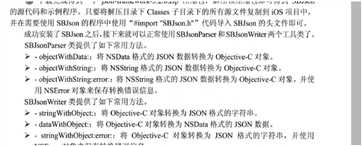标签:
JSON是一种广泛使用的数据交换格式,JSON同样具有跨平台、跨语言的优势,而且使用JSON作为数据交换格式时数据传输量更小。
JSON的全称是JavaScript Object Notation,即JavaScript 对象符号,它是一种轻量级的数据交换格式.JSON数据格式既适合人进行读/写,也适合计算机本身解析和生成。
|
JSON主要有如下两种数据结构 |
|
由key-value对组成的数据结构,在不同的语言中有不同的实现。例如,在JavaScript中是一个对象,在Objective-C中是一种NSDictionary对象,在C语言中则是一个struct,在其他语言中可能有record、dictionary、hash table等实现 |
|
有序集合,在不同语言中可能有NSArray、vector、数组和序列等实现。 |
|
在JavaScript中主要有两种JSON语法,其中一种用于创建对象,另一种用于创建数组。 |
JSON创建对象时,总是{开始,以}结束,对象的每个属性名和属性值之间以英文冒号(:)隔开,多个属性定义之间以英文逗号(,)隔开.语法格式如下:
1 object = 2 3 { 4 5 propertyName1 : propertyValue1, 6 7 propertyName2 : propertyValue2, 8 9 … 10 11 }
使用JSON语法创建数组总是以英文方括号( [ )开始,然后依次放入数组元素,元素与元素之间以英文逗号( , )隔开,最后一个数组元素后面不需要英文逗号,但以英文反方括号 ( ] ).使用JSON创建数组的语法格式如下:
arr = [value1 , value2,…];
|
对于Objective-C的JSON工具而言,同样提供类似的两个功能 |
|
将Objective-C对象转换成JSON格式的字符串 |
|
将JSON格式的字符串恢复成Objective-C对象 |
NSJSONSerialization类提供了如下类方法来支持JSON解析或生成

NSJSONSerialization只能将满足如下条件的对象转换为JSON数据

SBJson同样可以完成双向转换,它最主要的连个工具类就是SBJsonParser和SBJsonWriter,
其中SBJsonParser负责把NSData或NSString形式的JSON数据转换为Objective-C对象;
而SBJsonWriter则负责把Objective-C对象转换为NSData或NSString形式的JSON数据.


1 ViewController.m 2 3 #import “ViewController.h” 4 5 #import “SBJson.h” 6 7 #import “JSONKit.h” 8 9 @implementation ViewController 10 11 NSArray* books; 12 13 NSArray* parseResult; 14 15 NSString* tableTitle; 16 17 - (void)viewDidLoad 18 19 { 20 21 [super viewDidLoad]; 22 23 // 定义一个Objective-C的NSArray数据,该示例会使用3种方式将该对象转换为JSON数据 24 25 books = [NSArray arrayWithObjects: 26 27 [NSDictionary dictionaryWithObjectsAndKeys@”红楼梦”, @”title”, 28 29 @”曹雪芹 编著” , @”author”, 30 31 @”书写了清朝历史豪门的缩影”, @”remark” , nil ] , 32 33 [NSDictionary dictionaryWithObjectsAndKeys@”三国演义”, @”title”, 34 35 @”罗贯中 编著” , @”author”, 36 37 @”天下分久必合合久必分”, @”remark” , nil ] , 38 39 [NSDictionary dictionaryWithObjectsAndKeys@”西游记”, @”title”, 40 41 @”吴承恩 编著” , @”author”, 42 43 @”去西天取经”, @”remark” , nil ] , 44 45 [NSDictionary dictionaryWithObjectsAndKeys@”水浒传”, @”title”, 46 47 @”施耐庵 编著” , @”author”, 48 49 @”草根”, @”remark” , nil ] 50 51 ,nil]; 52 53 self.tableView.dataSource = self; 54 55 } 56 57 - (IBAction)JSONSerializationParser:(id)sender 58 59 { 60 61 // 获取JSON文件所在的路径 62 63 NSString* jsonPath = [[NSBundle mainBundle] pathForResource:@”books” 64 65 ofType@”json”]; 66 67 // 读取jsonPath对应文件的数据 68 69 NSData* data = [NSData dataWithContentsOfFile:jsonPath]; 70 71 // 解析JSON数据,返回Objective-C对象 72 73 parseResult = [NSJSONSerialization JSONObjectWithData:data 74 75 options:0 error:nil]; 76 77 tableTitle = @”使用JSONSerializationParse解析”; 78 79 // 让tableView重新加载数据 80 81 [self.tableView reloadData]; 82 83 } 84 85 - (IBAction)SBParser:(id)sender 86 87 { 88 89 // 获取JSON文件所在的路径 90 91 NSString* jsonPath = [[NSBundle mainBundle] pathForResource:@”books” 92 93 ofType:@”json”]; 94 95 // 读取jsonPath对应文件的数据 96 97 NSData* data = [NSData dataWithContentsOfFile:jsonPath]; 98 99 // 创建SBJsonParser对象 100 101 SBJsonParser* jsonParser = [[SBJsonParser alloc] init]; 102 103 parserResult = [jsonParser objectWithData:data]; 104 105 tableTitle = @”使用SBJson解析”; 106 107 // 让tableView重新加载数据 108 109 [self.tableView reloadData]; 110 111 } 112 113 - (IBAction)JSONKitParse:(id)sender 114 115 { 116 117 // 获取JSON文件所在的路径 118 119 NSString* jsonPath = [[NSBundle mainBundle] pathForResource:@”books” 120 121 ofType:@”json”]; 122 123 // 读取jsonPath对应文件的数据 124 125 NSData* data = [NSData dataWithContentsOfFile:jsonPath]; 126 127 // 调用JSONKit为NSData扩展的objectFromJSONData方法解析JSON数据 128 129 parseResult = [data objectFromJSONData]; 130 131 tableTitle = @”使用JSONKit解析”; 132 133 // 让tableView重新加载数据 134 135 [self.tableView reloadData]; 136 137 } 138 139 - (IBAction)JSONSerializtionGenerate:(id)sender 140 141 { 142 143 // 调用NSJSONSerialization的类方法将Objective-C对象转换为JSON数据 144 145 NSData* data = [NSJSONSerialization dataWithJSONObject:books 146 147 options:0 error: nil]; 148 149 // 将NSData格式的JSON数据转换为字符串 150 151 NSString* json = [[NSString alloc] initWithData:data 152 153 encoding:NSUTF8StringEncoding]; 154 155 NSLog(@”NSJSONSerialization 转换得到的字符串为:%@”, json); 156 157 } 158 159 - (IBAction)SBGenerate:(id)sender 160 161 { 162 163 // 创建SBJsonWriter对象 164 165 SBJsonWriter* jsonWriter = [[SBJsonWriter alloc] init]; 166 167 // 调用SBJsonWriter对象的方法将Objective-C对象转换为JSON字符串 168 169 NSLog(@”SBJson 转换得到字符串为: %@”, [jsonWriter stringWithObject: books]); 170 171 } 172 173 - (IBAction)JSONKitGenerate:(id)sender 174 175 { 176 177 // 调用JSONKit为NSArray对象扩展的JSONString方法将Objective-C对象转换为JSON字符串 178 179 NSLog(@”JSONKit 转换得到字符串为: %@”, [books JSONString]); 180 181 } 182 183 - (NSString*)tableView:(UITableView *)tableView 184 185 titleForHeaderInSection:(NSInteger)section 186 187 { 188 189 return tableTitle; 190 191 } 192 193 - (NSInteger)tableView:(UITableView*)tableView 194 195 numberOfRowsInSection: (NSInteger)section 196 197 { 198 199 // parseResult中包含多少个对象,该表格就显示多少行 200 201 retrun [parseResult count]; 202 203 } 204 205 - (UITableViewCell*)tableView:(UITableView*)tableView 206 207 cellForRowAtIndexPath:(NSIndexPath*)indexPath 208 209 { 210 211 // 根据动态单元格原型的ID来获取可重用单元格 212 213 UITableViewCell* cell = [tableView dequeueReusableCellWithIdentifier:@”bookCell” 214 215 forIndexPath: indexPath]; 216 217 // 获取当前行号在parserResult中对应的数据 218 219 NSDictionary* book = [parseResult objectAtIndex: indexPath.row]; 220 221 // 获取单元格中的3个控件,并为3个控件设置显示文本 222 223 UILabel* titleLabel = (UILabel*)[cell viewWithTag:1]; 224 225 titleLabel.text = [book objectForKey:@”title”]; 226 227 UILabel* authorLabel = (UILabel* )[cell viewWithTag:2]; 228 229 authorLabel.text = [book objectForKey:@”author”]; 230 231 UILabel* remarkLabel = (UILabel* )[cell viewWithTag:2]; 232 233 authorLabel.text = [book objectForKey:@”remark”]; 234 235 } 236 237 @end
|
标签:
原文地址:http://www.cnblogs.com/congli0220/p/5067953.html